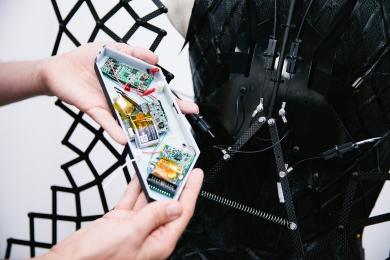 No matter what the material, at some point in human history people have used it for clothing. Lady Gaga wore a dress made of meat to the VMAs, Japanese Samuri had armor made from paper, and recently a line of air-purifying dresses made out of pollution absorbing flexible concrete have been causing a buzz as Catalytic Clothing. From the moment we first put a mixing bowl on our heads as a hat to the moment we have a mind blowing runway show, people never seem to stop being interested in alternative materials exploration for clothing their bodies.
No matter what the material, at some point in human history people have used it for clothing. Lady Gaga wore a dress made of meat to the VMAs, Japanese Samuri had armor made from paper, and recently a line of air-purifying dresses made out of pollution absorbing flexible concrete have been causing a buzz as Catalytic Clothing. From the moment we first put a mixing bowl on our heads as a hat to the moment we have a mind blowing runway show, people never seem to stop being interested in alternative materials exploration for clothing their bodies.
 Therefore, it has not been the least bit surprising to find that 3D printing has been making its way into the production of high fashion garments as the newest way push the boundaries of clothing. Unlike wedding dresses made from toilet paper and evening gowns created from kitchen sponges, however, it looks like 3D printing is offering a lot more opportunity for development.
Therefore, it has not been the least bit surprising to find that 3D printing has been making its way into the production of high fashion garments as the newest way push the boundaries of clothing. Unlike wedding dresses made from toilet paper and evening gowns created from kitchen sponges, however, it looks like 3D printing is offering a lot more opportunity for development.
Rather than using 3D printing technology to recreate garments that could otherwise be fabricated from conventionally manufactured textiles, it is being seen as a tool for reimagining the very foundations of the relationship between the human body and its clothing. At the 2015 New York Fashion Week, a particularly striking example of this new frontier sashayed down the catwalk as Chromat‘s Momentum line.
Sure the clothing all has style, flair, and pizzazz, all of the customary ingredients expected of haute couture, but the difference between these pieces and all the others doesn’t lie wholly in its appearance. It’s much deeper than that. Working closely with Intel, they developed a Curie Module, a small device that allows inputs to change the garments as they are worn.
Two pieces in particular, the Adrenaline Dress and the Aeros Sports Bra, included in the Momentum line utilize the Curie Module in combination with material that is 3D printed out of shape memory alloys. This gives both of these garments the potential to react to specific input from the wearer’s body.
 In the case of the sports bra, more traditionally conceived sport textile materials such as lycra, mesh, and neoprene are used in conjunction with 3D printed vents to create a garment that can become more open or closed depending on the temperature of the body it is covering.
In the case of the sports bra, more traditionally conceived sport textile materials such as lycra, mesh, and neoprene are used in conjunction with 3D printed vents to create a garment that can become more open or closed depending on the temperature of the body it is covering.
The Adrenaline Dress is fabricated from carbon fiber and neoprene activated by a shape memory allow that expands as the wearer’s adrenaline levels rise. Shape memory alloys, also known as smart metals, are themselves a fascinating material because of their ability to react in specific ways to changes in a particular input. These metals have been integrated into architectural design, such as window shades whose metals retract when cool and extend when heated to automatically modulate the light coming in through the window in relationship to the temperature of the room.
3D print design is attributed to Francis Bitoni Studio, behind several other incredible 3D printed fashion pieces we’ve seen, and the actual 3D printing was done by Voodoo Manufacturing. 3D body scanning is credited to Sketchfab.
The founder of Chromat, Becca McCharen, is an architect and designer and these garments reflect both that background and the possibilities present when combining knowledge from a wide array of fields. Obviously not meant to move directly from runway to store rack, these pieces do, however, offer a glimpse of what the future of clothing might look like.
What are your thoughts on this 3D printed dress? Discuss in the Adrenaline Dress forum thread on 3DPB.com.Check out the runway below:
Subscribe to Our Email Newsletter
Stay up-to-date on all the latest news from the 3D printing industry and receive information and offers from third party vendors.
You May Also Like
Precision at the Microscale: UK Researchers Advance Medical Devices with BMF’s 3D Printing Tech
University of Nottingham researchers are using Boston Micro Fabrication‘s (BMF) 3D printing technology to develop medical devices that improve compatibility with human tissue. Funded by a UK grant, this project...
3D Printing Webinar and Event Roundup: April 21, 2024
It’s another busy week of webinars and events, starting with Hannover Messe in Germany and continuing with Metalcasting Congress, Chinaplas, TechBlick’s Innovation Festival, and more. Stratasys continues its advanced training...
3D Printing Webinar and Event Roundup: March 17, 2024
It’s another busy week of webinars and events, including SALMED 2024 and AM Forum in Berlin. Stratasys continues its in-person training and is offering two webinars, ASTM is holding a...
3D Printed Micro Antenna is 15% Smaller and 6X Lighter
Horizon Microtechnologies has achieved success in creating a high-frequency D-Band horn antenna through micro 3D printing. However, this achievement did not rely solely on 3D printing; it involved a combination...






























